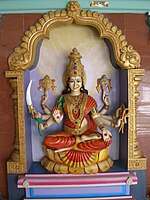| Ashta Lakshmi | |
|---|---|
| Goddess of Prosperity and Wealth Supreme Goddess in Vaishnavism | |
 Ashtalakshmi - Eight forms of Lakshmi Ashtalakshmi - Eight forms of Lakshmi | |
| Devanagari | अष्टलक्ष्मी |
| Sanskrit transliteration | aṣṭalakṣmī |
| Affiliation | Lakshmi, Sri Vaishnavism, Mahadevi |
| Abode | Vaikuntha, Manidvipa |
| Mantra | Ashtalakshmi Stotra |
| Weapon | Khanda (sword), Bow and Arrow, Trishula (Trident), Chakra (discus), Gada (mace), Ankusha (goad) and Shield |
| Mount | Lotus, Owl, Eagle, Lion, Elephant |
| Consort | Vishnu |
Ashta Lakshmi (Sanskrit: अष्टलक्ष्मी, IAST: Aṣṭalakṣmī; lit. "Octet of Lakshmi") or Ashtalakshmi, is a group of the eight manifestations of Lakshmi, the Hindu goddess of prosperity. She presides over eight sources of wealth: spirituality, material wealth, agriculture, royalty, knowledge, courage, progeny, and victory.
The Ashta Lakshmi are always depicted and worshipped as an octet in temples.
Iconography
Adi Lakshmi
 Adi Lakshmi
Adi Lakshmi
Adi Lakshmi (Primeval Lakshmi) is portrayed to be the earliest forms of Lakshmi.
Adi Lakshmi is the manifestation who supports a seeker to reach their source, or Atman. She is believed to proffer dhyana, a state of absolute silence, bliss, and peace. This aspect of the goddess is responsible for the furtherance in the quest for spiritual wealth.
She is depicted as four-armed, carrying a lotus and a red flag, and other two arms expressing the abhaya mudra (fearlessness pose) and the varada mudra (blessing pose).
Dhana Lakshmi
 Dhana Lakshmi
Dhana Lakshmi
Dhana Lakshmi (Wealth Lakshmi) is Lakshmi in her form as the goddess of material wealth.
Dhana Lakshmi is depicted with six hands, in red garments, carries the Sudarshana Chakra, shankha, kalasha (a water pitcher with mango leaves and a coconut on it) or the Amrita Kalasha (a pitcher containing Amrita – the elixir of life), a bow and arrow, a lotus, and an arm performing the abhaya mudra, with gold coins falling from it.
Dhanya Lakshmi
 Dhanya Lakshmi
Dhanya Lakshmi
Dhanya Lakshmi (Grain Lakshmi) is the form of Lakshmi who represents the wealth of agriculture. Dhanya Lakshmi is also the aspect of Lakshmi who provides resources to adherents for their sustenance and well-being.
She is depicted as eight-armed, dressed in green garments, carrying two lotuses, a gada (mace), paddy crop, sugarcane, and bananas. Her hands express the abhaya mudra and the varada mudra.
Gaja Lakshmi
 Gaja Lakshmi
Gaja Lakshmi
Gaja Lakshmi (Elephant Lakshmi) is the giver of animal wealth (such as cattle), or the being who offers royal splendour, according to the Narayana Pancharatra.
According to Hinduism, Gaja Lakshmi restored the potent lost by Indra (King of the devas) during the Samudra Manthana. Vasudha Narayanan has interpreted this name as the, "one who is worshipped by elephants".
She is depicted as four-armed, donning red garments, carrying two lotuses, two arms expressing the abhaya mudra and the varada mudra, surrounded by two elephants bathing her with water pots.
Santana Lakshmi
 Santhana Lakshmi
Santhana Lakshmi
Santana Lakshmi (Eternal Lakshmi) is the goddess's manifestation who bestows offspring.
She is depicted as six-armed, carrying two kalashas (water pitcher with mango leaves and a coconut on it), a sword, a shield, a child on her lap, a hand in abhaya mudra, and the other holding Prana as a child holding the lotus (it's indirectly implied in Skanda Purana).
Dhairya Lakshmi
 Veera/Dhairya Lakshmi
Veera/Dhairya Lakshmi
Dhairya Lakshmi (Courage Lakshmi), or Veera Lakshmi (Valourous Lakshmi), is a form of Lakshmi inspired by Durga. She is the form of the goddess who bestows valour during battles and courage plus strength for overcoming difficulties in life.
She is depicted as eight-armed, seated on a lion, in red garments, carrying a chakra, shankha, bow, arrow, trishula (or a sword), a bundle of palm leaf scriptures, other two hands in the abhaya mudra and the varada mudra.
Vijaya Lakshmi
 Vijaya Lakshmi
Vijaya Lakshmi
Vijaya Lakshmi or Jaya Lakshmi (Victorious Lakshmi) is also a manifestation drawn from Durga. She is form of the goddess who bestows victory, not only in battles, but also for conquering hurdles in order to achieve success.
She is depicted as eight-armed, dressed in blue garments, carrying the chakra, shankha, sword, shield, lotus, pasha, and other two hands expressing the abhaya mudra and the varada mudra.
Vidya Lakshmi
 Vidya Lakshmi
Vidya Lakshmi
Vidya Lakshmi (Knowledge Lakshmi) is the goddess and the bestower of knowledge of arts and the sciences.
She is dressed in a white saree and has a resemblance to the goddess Saraswati. She holds a book of the Vedas, a peacock feather as a pen, the varada mudra and the abhaya mudra.
Other forms
In some Ashta Lakshmi lists, other forms of Lakshmi are included:
- Aishvarya Lakshmi (Auspicious Lakshmi): The goddess who bestows auspices, and the only form of Lakshmi who mounts a horse. She generally replaces Vidya Lakshmi from the Ashta Lakshmi list.
- Saubhagya Lakshmi (Fortune Lakshmi): The manifestation who furnishes good fortune.
- Rajya Lakshmi (Royal Lakshmi): The form of Lakshmi who bestows majesty, revered by monarchs.
- Vara Lakshmi (Boon Lakshmi): The form of the goddess who bestows boons. This form of Lakshmi is venerated on the occasion of Varalakshmi Vratam.
Worship

Around the 1970s, a leading Sri Vaishnava theologian, UV Srinivasa Varadachariar, published a hymn called the Ashtalakshmi Stotra dedicated to the eight forms of Lakshmi. Narayanan comments:
“Although these attributes (which represent the wealths bestowed by the Ashta Lakshmi) of Sri (Lakshmi) can be found in traditional literature, the emergence of these eight (Ashta Lakshmi goddesses) in precisely this combination is, as far as I can discern, new.”
The prayer Ashtalakshmi Stotra lists all of the Ashta Lakshmi, in which the goddess is depicted as seated on a lotus. The rise in popularity of the Ashta Lakshmi can be linked with the rising popularity of the Ashtalakshmi Stotra.
Ashta Lakshmi is now widely worshipped both by Sri Vaishnava and other Hindu communities in South India. Occasionally, Ashta Lakshmi is depicted together in shrines or in "framing pictures" within an overall design and are worshipped by votaries of Lakshmi who worship her in her various manifestations. In addition to emergence of Ashta Lakshmi temples since the 1970s, traditional silver articles used in home worship as well as decorative jars (kumbha) now appear with the Ashta Lakshmi group molded on their sides.
Books, popular prayers manuals, pamphlets sold outside temples in South India, ritual worship, and "a burgeoning audiocassette market" also presently popularise the octet of Lakshmi.
Temples

- Ashtalakshmi Temple, Besant Nagar, Chennai, Tamil Nadu, India: The Ashta Lakshmi Kovil, built in 1974, is the first shrine dedicated exclusively to the Ashta Lakshmi where Lakshmi is given greater importance than Vishnu. It has eight small shrines arranged in clockwise direction, dedicated to the Ashta Lakshmi and then a ninth shrine dedicated to Vishnu and Lakshmi together, unlike the traditional separate shrines.
- Ashtalakshmi Temple, Vasavi Colony, Dilsukh Nagar, Hyderabad, Andhra Pradesh, India
- Sydney Durga Temple - The Hindu Temple, located in Regents Park, Sydney, Australia has 8 small sanctums dedicated to the Ashta Lakshmi.
- Ashtalakshmi Temple, Sugar Land, Houston, Texas, United States
- Ashtalakshmi Temple, North Hollywood, California, United States
- At the entrance - leading from Vittavasal Street to Meenakshi Temple, Madhurai, a mandapam (Hall) called Ashta Lakshmi Mandapam is dedicated to the Ashta Lakshmi, the statues of which support the roof on either side.
- Parashakthi Temple, Pontiac, Michigan has the deities installed there.
- Asta Lakshmi Devasthanam, Fremont, California.
- Sree Vasudevapuram Mahavishnu temple situated in Ernakulam district of Kerala India conducts the Ashtalakshmi Thampoolasamprana Mahotsavam every year starting on the eve of Akshaya Tritheye. The belief is that Maha Lakshmi gives darshan and shower blessings on devotees only on eight days in a year as Ashta Lakshmi. The most auspicious ritual of the temple known as the Thampoolasamarpanam is performed during the mahotsavam.
See also
References
- ^ Parashakthi temple, Michigan. "Ashta Lakshmi". Archived from the original on 2007-02-12.
- ^ Vasudha Narayanan in: John Stratton Hawley, Donna Marie Wulff p.104
- ^ Flipside of Hindu Symbolism (Sociological and Scientific Linkages in Hinduism) by M. K. V. Narayan; published 2007 by Fultus Corporation; 200 pages; ISBN 1-59682-117-5; p.93
- www.wisdomlib.org (2015-11-22). "Gajalakshmi, Gajalakṣmī, Gaja-lakshmi: 4 definitions". www.wisdomlib.org. Retrieved 2022-08-13.
- www.wisdomlib.org (2020-02-29). "The Curse of Wind-god [Chapter 19]". www.wisdomlib.org. Retrieved 2024-05-07.
- www.wisdomlib.org (2015-11-22). "Santanalakshmi, Santānalakṣmī, Santana-lakshmi, Samtanalakshmi: 2 definitions". www.wisdomlib.org. Retrieved 2022-08-13.
- ^ Swami Chidananda. "The Eightfold Lakshmi".
- ^ Studies in Hindu and Buddhist Art By P. K. Mishra, p. 34
- Vasudha Narayanan in: John Stratton Hawley, Donna Marie Wulff p.108
- Vasudha Narayanan in: John Stratton Hawley, Donna Marie Wulff p.105
- Vasudha Narayanan in: John Stratton Hawley, Donna Marie Wulff p.109 "The effect is to cast Vishnu as the consort of Lakshmi than the other way around, as has been traditional"
- Vasudha Narayanan in: John Stratton Hawley, Donna Marie Wulff pp.108-9
- "Ashtalakshmi Temple, Hyderabad". My city pedia. Archived from the original on 2006-04-26.
- "Official website of Ashtalakshmi Temple, Houston". Ashtalakshmi Temple, Houston.
- "Official website of Ashtalakshmi Temple, North Hollywood".
- Our Deities – Ashta Lakshmi (and Durga Mahalakshmi) – OM Shakthi – Parashakthi Temple Archived July 5, 2008, at the Wayback Machine
- "Asta Lakshmi Devasthanam". Archived from the original on 2015-07-08. Retrieved 2015-07-07.
Further reading
- Studies in Hindu and Buddhist Art By P. K. Mishra, Published 1999, Abhinav Publications,413 pages, ISBN 81-7017-368-X
- Vasudha Narayanan in Chapter ŚRĪ: Giver of Fortune, Bestower of Grace in book Devī: Goddesses of India By John Stratton Hawley, Donna Marie Wulff; Published 1996; University of California Press; 373 pages;ISBN 0-520-20058-6
External links
| Hindu deities and texts | ||
|---|---|---|
| Gods |  | |
| Goddesses | ||
| Other deities | ||
| Texts (list) | ||
